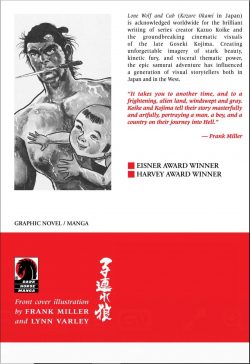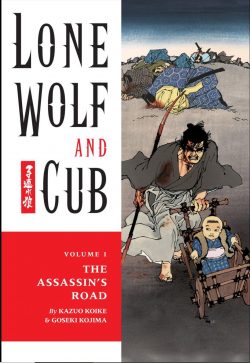

By Kazuo Koike & Goseki Kojima, translated by Dana Lewis (Dark Horse Manga)
ISBN: 978-1-56971-502-4 (TPB)
Best known in the West as Lone Wolf and Cub, the epic Samurai saga created by Kazuo Koike & Goseki Kojima is without doubt a global classic of comics literature. An example of the popular “Chanbara†or “sword-fighting†genre of print and screen, Kozure Okami was serialised in Weekly Manga Action from September 1970 until April 1976. It was an immense and overwhelming “Seinen†(“Men’s mangaâ€) hit…
Those tales quickly prompted thematic companion series Kubikiri Asa (Samurai Executioner) which ran from 1972-1976, but the major draw – at home and, increasingly, abroad – was always the nomadic wanderings of doomed noble ÅŒgami IttÅ and his solemn silent child.
Revered and influential, Kozure Okami was followed after years of supplication by fans and editors by sequel Shin Lone Wolf & Cub (illustrated by Hideki Mori) and even spawned – through Koike’s indirect participation – science fiction homage Lone Wolf 2100 by Mike Kennedy & Francisco Ruiz Velasco.
The original saga has been successfully adapted to most other media, spawning movies, plays, TV series (plural), games and merchandise. The property is notoriously still in pre-production in Hollywood.
The several thousand pages of enthralling, exotic, intoxicating narrative art produced by these legendary creators eventually filled 28 collected volumes, beguiling generations of readers in Japan and, inevitably, the world. More importantly, their philosophically nihilistic odyssey – with its timeless themes and iconic visuals – has influenced hordes of other creators.
The many manga, comics and movies these stories have inspired around the globe are impossible to count. Frank Miller, who illustrated the cover of this edition, referenced the series in Daredevil, his dystopian opus Ronin, The Dark Knight Returns and Sin City. Max Allan Collin’s Road to Perdition is a proudly unashamed tribute to the masterpiece of vengeance-fiction. Stan Sakai has superbly spoofed, pastiched and celebrated the wanderer’s path in his own epic Usagi Yojimbo, and even children’s cartoon shows such as Samurai Jack are direct descendants of this astounding achievement of graphic narrative. The material has become part of a shared world culture.
In the West, we first saw the translated tales in 1987, as 45 Prestige Format editions from First Comics. That innovative trailblazer foundered before getting even a third of the way through the vast canon, after which Dark Horse Comics assumed the rights, systematically reprinting and translating the entire epic into 28 tankÅbon-style editions (petite 153 x 109 mm monochrome trade paperbacks, of about 300 pages each) between September 2000-December 2002. Once the entire translated epic had run its course, it was all placed online through the Dark Horse Digital project.
Following a cautionary ‘Note to Readers’ – on stylistic interpretation – this moodily magnificent monochrome collection truly gets underway, keeping many terms and concepts western readers may find unfamiliar. Therefore this initial lean, mean, martial edition offers at the close a Glossary providing detailed context on the term used in the stories, plus profiles of author Koike Kazuo & illustrator Kojima Goseki and the first instalment of ‘The Ronin Report’: an occasional series of articles offering potted history essays on the period of the Tokugawa Shogunate, with Tim Ervin starting the ball rolling here.
Of course, the true meat is the captivating, grimly compelling combination of revenge fable and action-adventure which opens here with intriguing episodes of stripped-down mystery, gripping intensity and galvanic bloodletting as the first tale introduces a scruffy indigent pushing a homemade bamboo pram with a 3-year-old boy in it.
A banner on the contraption proclaims ‘Son for Hire, Sword for Hire’ and as the man stoically ignores mockery and derision from louts on the road, his promotional ploy attracts the attention of four deadly men who have been warned of an assassin carrying his baby boy with him…
A basic formula informs early episodes: the acceptance of a commission to kill an impossible target necessitates the forging of a cunning plan and relentless determination leads to inevitable success: all underscored with bleak philosophical musings alternately informed by Buddhist teachings in conjunction with or in opposition to the unflinching personal honour code of Bushido…
You won’t learn it until the end of this tome, but the fore-doomed killer-wanderer was once the Shogun’s official executioner: capable of cleaving a man in half with one stroke. An eminent individual of esteemed imperial standing, elevated social position and impeccable honour, ÅŒgami IttÅ lost it all and now roams feudal Japan as a doomed soul hellbent for the dire, demon-haunted underworld of Meifumado.
When the noble’s wife was murdered and his clan dishonoured due to the machinations of the treacherous and politically ambitious Yagyu Clan, the Emperor ordered ÅŒgami to commit suicide. Instead, he rebelled, choosing to become a despised Ronin (masterless samurai) and assassin, pledging to revenge himself on the traitors until they were all dead or Hell claimed him. His son, toddler Daigoro, also chose the way of the sword and together they roam the grim and evocative landscapes of feudal Japan, one step ahead of doom and with death behind and before them.
Frequently, the infallible assassin’s best ploy is to allow himself to be captured, endure unimaginable torture and then fight his way out having slaughtered his target…
The tactic is again employed in ‘A Father Knows His Child’s Heart, As Only a Child Can Know His Father’s’ with the wolf despatching willing Daigoro to penetrate the unyielding defences of Takai Han so Papa can kill a dishonourable usurper…
Another aspect of ÅŒgami’s methodology emerges in ‘From North to South, From West to East’. The assassin always insists on a personal interview with every client and demands not only who is to die, but why. Perhaps the cautious killer only wants to know the extent of what he’s getting into, but we know he’s judging: seeing whether the target deserves death… or if the client does…
The legend of the Lone Wolf and Cub quickly spreads, and when faithful guards briefly hire Daigoro to help their beloved mistress, it is with full knowledge of what the boy’s father is. In ‘Baby Cart on the River Styx’ that knowledge is crucial to ÅŒgami’s plan for quashing a gang turf-war before it begins, even whilst bringing down a corrupt yet untouchable lord…
Shocking for us may be the accepted conceit that father is fully prepared to sacrifice son to achieve the mission and fulfil his promises. ‘Suio School Zanbato’ sees Daigoro willingly become a hostage to fortune so that his dad can lure a swords-master – and all his honourless students – into an officially sanctioned duel, killing all with no legal ramifications or repercussions…
Lyrically twisting the theme of star-crossed lovers, ‘Waiting for the Rains’ sees the lad befriend a dying woman even as his father stoically anticipates completing his next commission – expunging the man she so patiently awaits…
These stories are deeply metaphorical and work on many levels most of us westerners just won’t grasp on first reading – even with contextual aid provided by the bonus features. That only makes them more exotic and fascinating. Also a little unsettling is the even-handed treatment of women in the tales. Within the confines of the notoriously stratified culture being depicted, females – from servants to courtesans, prostitutes to highborn ladies – are all fully rounded characters, with their own motivations and drives. The wolf’s female allies are valiant and dependable, and his foes, whether targets or mere enemy combatants in his path, are treated with professional respect by ÅŒgami. He kills them just as if they were men…
In ‘Eight Gates of Deceit’ the indomitable killer is ambushed by an octet of female assassins hired by his latest client who foolishly chooses to discount the professional honour of his hireling in favour of clearing up loose ends. It’s his last mistake…
‘Wings to the Birds, Fangs to the Beast’ finds the tireless wanderer stumbling into a hot-spa village recently taken over by bandits. To their eternal cost, and despite the newcomer’s every forbearing effort, the human animals refuse to believe the man with the baby-carriage wants no trouble…
This stunning opening collection ends with a few of the answers readers want as the scene shifts to the recent past at the Shogun’s palace in Edo for an origin. There, thanks to political manoeuvrings of ambitious Lord Yagyu, Shogun’s Executioner ÅŒgami IttÅ has been ousted and his clan disgraced. With his wife Asami dead, the austere warrior outwits his opponent – who thought honourable suicide the only option he’d left his enemy – by opting to travel ‘The Assassin’s Road’with his baby son momentously choosing to follow him to Meifumado or victory…
Whichever English transliteration you prefer – Wolf and Baby Carriage is what I was first introduced to – the grandiose, thought-provoking hell-bent Samurai tragedy created by Kazuo Koike & Goseki Kojima is without doubt one of those all too rare breakthrough global classics of comics literature. A breathtaking tour de force, these are comics you must not miss.
© 1995, 2000 Kazuo Koike & Goseki Kojima. All other material © 2000 Dark Horse Comics, Inc. Cover art © 2000 Frank Miller. All rights reserved.
